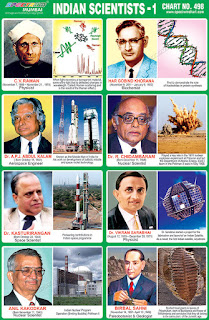 |
| Indian Scientists 1 Chart |
Spectrum Chart - 498 : Indian Scientists 1
1. Dr. C. V. Raman (Physicist) -
Chandrasekhara Venkata Raman was an Indian physicist, who carried out
ground-breaking work in the field of light scattering, what now is
called the 'Raman Effect', which earned him the 1930 Nobel Prize for
Physics. In 1954, India honoured him with its highest civilian award,
the Bharat Ratna.
2. Har Gobind Khorana (Biochemist) - Har
Gobind Khorana was an Indian-American biochemist who shared the 1968
Nobel Prize for Physiology or Medicine for his research that showed
how the order of nucleotides in nucleic acids, which carry the
genetic code of the cell, control the cell’s synthesis of proteins.
3. Dr. A. P. J. Abdul Kalam (Aerospace
Engineer) – Dr. A. P. J. Abdul Kalam was involved in India's
civilian space program and military missile development efforts. He
also played a pivotal organisational, technical, and political role
in India's Pokhran-II nuclear tests in 1998. He was known as the
Missile Man of India for his work on the development of ballistic
missile and launch
vehicle technology.
Later he became the 11th President of India from 2002 to
2007.
4. Dr. R. Chidambaram (Nuclear Scientist)
- Rajagopala Chidambaram is an Indian Nuclear Scientist. Chidambaram
played a key role in developing India's nuclear weapons, being a part
of the team conducting the first Indian nuclear test at Pokhran Test
Range in 1974. He then led and represented the team of the Department
of Atomic Energy (DAE) while observing and leading efforts to conduct
the second nuclear tests in May 1998. Currently he is serving as the
principal scientific adviser to the federal Government of India.
5. Dr. Kasturirangan (Space Scientist) –
Dr. Krishnaswamy Kasturirangan is an Indian space scientist who
headed the Indian Space Research Organisation (ISRO) from 1994 to
2003. Under his leadership, the programme witnessed several major
milestones including the successful launching and operationalisation
of the India's prestigious launch vehicles, the Polar Satellite
Launch Vehicle and the Geosynchronous Satellite Launch Vehicle. He
has also made extensive and significant contributions to studies of
cosmic x-ray and gamma ray sources and effect of cosmic x-rays in the
lower atmosphere.
6. Dr. Vikram Sarabhai (Physicist) -
Vikram Sarabhai was an Indian physicist, scientist and innovator
widely regarded as the father of India's space programme. Vikram
Sarabhai did research on the time variations of cosmic rays and
concluded that meteorological effects could not entirely affect the
observed daily variations of cosmic rays. Vikram Sarabhai visualised
a new field of research opening up in solar and interplanetary
Physics.
7. Anil Kakodkar (Nuclear Scientist) - Dr
Anil Kakodkar is a very distinguished nuclear scientist of India.
Anil Kakodkar also has the credit of being a member of the core team
of architects of India's Peaceful Nuclear Tests that were conducted
during the years 1974 and 1998. He is known for being a strong
advocate of India's self-reliance in energy, especially by use of the
cheap national thorium resources. He was the director of the Bhabha
Atomic Research Centre at Trombay from the year 1996-2000. From the
year 2000 onwards, he has been leading the Atomic Energy Commission
of India and playing secretary to the Department of Atomic Energy.
With active support from Homi Bhabha, Vikram Sarabhai, set up the
first Rocket Launching station (TERLS) in the India at Thumba near
Thiruvananthapuram.
8. Birbal Sahni (Paleobotanist &
Geologist) - Birbal Sahni was an Indian paleobotanist who studied the
fossils of the Indian subcontinent, was also a geologist who took an
interest in archaeology. His greatest contributions lie in the study
of botany of the plants of India is well as paleobotany. He was
elected a Fellow of the Royal Society of London (FRS) in 1936, the
highest British scientific honour, awarded for the first time to an
Indian botanist. He was elected as an Honorary President of the
International Botanical Congress, Stockholm in 1950, but he died
before he could serve.

No comments:
Post a Comment